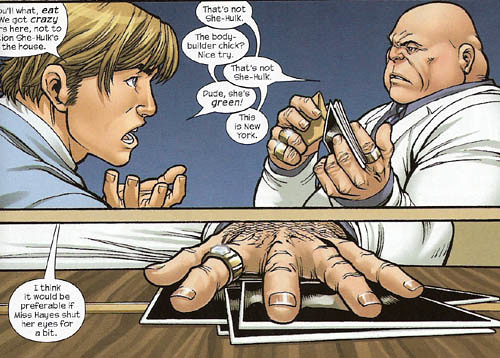Runaways (v. 9): Dead Wrong
Collects: Runaways v. 3 #1-6 (2008-9)
Released: June 2009 (Marvel)
Format: pages / color / $15.99 / ISBN: 9780785129400
What is this?: The Runaways head back to LA and find a new set of adversaries waiting for them, while Chase has to find a job.
The culprits: Writer Terry Moore and penciler Humberto Ramos
When Joss Whedon took over for Brian K. Vaughn as Runaways writer, the choice was logical, and it worked out — Whedon was different, but he brought his own strengths to the title. When Terry Moore was chosen to succeed the glacially paced Whedon, the choice was also logical. But whatever Moore brought to Runaways, it sure as hell wasn’t his strengths.

But put that aside for a moment. Moore has the team acting out of character for most of the book. It’s intentional, or so we’re supposed to believe: a spell gone awry. Leaving alone for a moment that the spell that caused the problem for the Runaways had a completely different effect on their opponents, I believe making established characters act out of character is a bad choice for a writer in his first assignment on a new title. It doesn’t instill any confidence, and it certainly doesn’t get the writer into a rhythm with the new characters. But more importantly, the characters don’t feel right, and the characters are what make Runaways important.
There’s a lot that doesn’t feel right. The Runaways find one of their parents’ hidden safehouses, but they don’t think to search for a cache of money and supplies? What kind of criminal masterminds don’t have emergency cash lying around? Why does the house have, instead of normal-but-lethal safeguards that won’t attract much attention, big fuzzy automated demons that destroy all sorts of stuff and practically scream for attention? Given how concerned the neighbors turn out to be, that would be a problem. And why does Moore think I’ll be entertained by radio shock jock Val Rhymin? To get across the characterization, penciler Humberto Ramos draws him as a younger, cut-rate Howard Stern; it’s also painfully obvious he has mind-control powers that Chase is somehow immune to. (And if he’s really so popular, how did Chase get hired so easily by him?) And haven’t I seen the ending to Dead Wrong before? Oh, yes, I did — right here. Didn’t even have the courtesy to change the age range of the characters.
Lesson here, boys and girls, is that heroes will likely be stupid. But aliens will likely be even more dense, so it’s OK.
I enjoyed Ramos’s work with Paul Jenkins when they were teamed up on various Spider-titles; Ramos’s distorted, exaggerated style works with a character as kinetic as Spider-Man, combined with the lack of expressiveness of his mask. However, Ramos feels all wrong for Runaways. In large scenes, the action looks muddled and confused; in the opening fight with the Majesdanians, I had no idea what was going on half the time. Xavin’s frequent transformations meant I had trouble figuring out who he was supposed to be most of the time. When it came down to it, I rarely could tell the difference between Ramos’s Carolina and Chase — and they’re not even the same gender, just the same hair color. It’s just a big mess full of undifferentiated hipsterwear and unkempt hair.
I am a big fan of Runaways, but I’m not such a big fan that I’m going to try to push this fragrant flower on you. Give this a pass. I’d advise doing the same with the next Runaways trade — featuring the shocking secret of Val Rhymin! Gosh! How exciting! — but I’m a big enough of a glutton I might not be able to help myself. I don’t know if I’m going to justify spending some majority fraction of $15 for it, though.
Rating: ![]() (1 of 5)
(1 of 5)
Labels: 1, Humberto Ramos, Los Angeles, Marvel, Runaways, Terry Moore





 Instead,
Instead,  I can’t really put a more definitive finger on what bothers me about Michael Ryan’s artwork; although I don’t like it, his style fits the title very well — modern, slightly manga, lean and glossy. On the other hand, sometimes his work is a little too manga for me to take seriously; for instance, he uses the comically oversized sweat beads on characters’ temples at moments of stress. And there are moments of art dodginess as well, as when the Kingpin displays a hand with five fingers but no thumb. However, I suppose I have to give Ryan tentative approval.
I can’t really put a more definitive finger on what bothers me about Michael Ryan’s artwork; although I don’t like it, his style fits the title very well — modern, slightly manga, lean and glossy. On the other hand, sometimes his work is a little too manga for me to take seriously; for instance, he uses the comically oversized sweat beads on characters’ temples at moments of stress. And there are moments of art dodginess as well, as when the Kingpin displays a hand with five fingers but no thumb. However, I suppose I have to give Ryan tentative approval.  In the first story, Molly gets a chance to shine as she’s thrown into a group of pre-teen runaways and immediately has to become their leader in a rebellion against the Proctor, the Fagin-like adult controlling them. Molly, shown at her most mature, immediately after reveals her childhood vulnerabilities. It’s not unmissable, but it is entertaining with an ending that is moving without being precious.
In the first story, Molly gets a chance to shine as she’s thrown into a group of pre-teen runaways and immediately has to become their leader in a rebellion against the Proctor, the Fagin-like adult controlling them. Molly, shown at her most mature, immediately after reveals her childhood vulnerabilities. It’s not unmissable, but it is entertaining with an ending that is moving without being precious. 